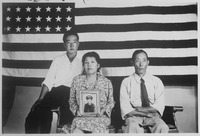Poston War Relocation Center
Poston was built on the Colorado River Indian Reservation, over the objections of the Tribal Council, who refused to be a part of doing to others what had been done to their tribe.
[3] A single fence surrounded all three camps, and the site was so remote that authorities considered building guard towers to be unnecessary.
As Time wrote, "After 15 months at Arizona's vast Poston Relocation Center as a social analyst, Commander Leighton concluded that many an American simply fails to remember that U.S. Japanese are human beings.
"[4] When Poston was chosen as the site for the relocation center, the Colorado River Indian Reservation Tribal Council adamantly opposed the use of their land because they did not want to be involved in inflicting the same injustice they had faced on the Japanese internees.
[5] The council was soon overridden, and the BIA and WRA jointly took control of 71,000 acres (29,000 ha) of tribal land and began construction in early 1942.
[6] Around two-thirds of Poston's population were brought directly from their homes to what was then Parker Dam, and many of these early arrivals volunteered to help complete the still-under-construction camps.
[1][3] Upon completion, the Poston site consisted of hundreds of residential barracks, a hospital, an administrative center, and guard and staff housing.
The camp officially opened as the Colorado River Relocation Center on June 1, 1942, and the BIA relinquished its authority over Poston in 1943.
Japanese Americans across the West Coast were uprooted from their lives and placed in different camps around the United States, including Poston.
[12] Some elements made life at Poston livable for internees, but their time at the camp was mostly filled with frustration and struggles to the end of their internment.
We're trapped like rats in a wired cage, To fret and fume with impotent rage; Yonder whispers the lure of the night, But that DAMNED FENCE assails our sight.
We seek the softness of the midnight air, But that DAMNED FENCE in the floodlight glare Awakens unrest in our nocturnal quest, And mockingly laughs with vicious jest.
Loyalty we know, and patriotism we feel, To sacrifice our utmost was our ideal, To fight for our country, and die, perhaps; But we're here because we happen to be Japs.
Hundreds of "Dear Miss Breed" postcards and letters are now part of the permanent archives at the Japanese American National Museum[15] and were the basis for a 2006 book, Dear Miss Breed: True Stories of the Japanese American Incarceration during World War II and a Librarian Who Made a Difference, by Joanne Oppenheim.
[17] A novel by Cynthia Kadohata, Weedflower, illustrates the life of a Japanese-American girl and her family after the bombing of Pearl Harbor, when they are incarcerated at Poston.
This memoir shows how the power of family, love, and relentless hard work helped to overcome the huge personal and material losses endured by internees.
She remembers soldiers coming to her front door with rifles to take them to Poston, and being behind barbed wire in the middle of the desert.
[21] The Japanese American Memorial to Patriotism During World War II, located in Washington, DC, features inscriptions of the names of those confined to the Poston center.

